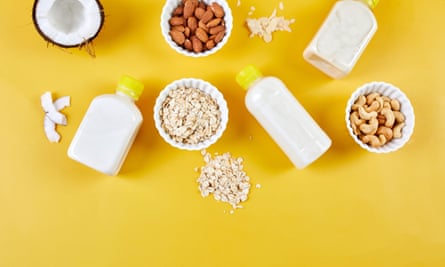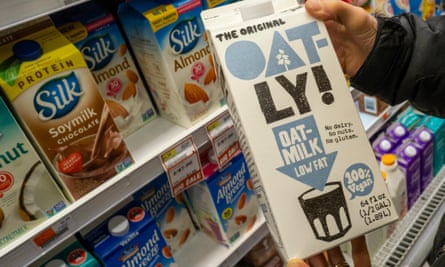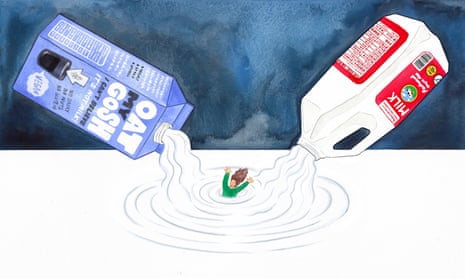Over the past decade, non-dairy milks have soared in popularity. Part of this is because of concerns about the climate crisis: the dairy industry is uniquely bad for the environment in part because of the amount of methane cattle produce. But many have also switched to non-dairy citing concerns about cruelty to animals, an exploration of veganism, an increasing awareness of lactose intolerance, concerns about fat and sugar and even worries about good skin.
There are lots of ways plant milks are preferable to dairy but in one respect they’re definitely not: on average, plant milks now cost twice as much as good, old-fashioned cow’s milk, which has been building strong teeth and bones and warding off osteoporosis for thousands of years, and the cost difference is making some consumers reconsider.
“I have an Aldi and Lidl by me,” says Su-Jit Lin, a food writer in Atlanta, “and that milk can go as low as $1.25 for a half-gallon. So why not get a half-gallon of dairy milk when almond milks are $3 and change?”
Bon Appétit found that the cheapest whole dairy milk at supermarkets was two cents an ounce at Walmart, while almond milk cost four cents and oat six cents.
It’s enough to give some plant milk drinkers, including Lin, pause.
But why are plant milks so expensive when they’re really nothing more than a handful of oats, almonds or soybeans pulverized in a blender with some water? As another astute Twitter user points out, surely it doesn’t cost nearly as much to raise an oat as it does a cow.

To see if there were some hidden costs I was somehow missing, I made my own oat milk. The recipe I used called for a cup of oats (approximate value: 38 cents), a pinch of salt (infinitesimal), eight cups of water (free), and a blender and strainer (cost of both unknown). All told, the experiment took about 40 minutes, including the half hour required to soak the oats. In the end, it tasted like water mixed with pulverized oats. The glow of virtue and smugness from making my own oat milk (priceless) didn’t offset how terrible it tasted. Califia Farms’ extra creamy oat milk is, like mine, mostly oats, water and salt, but it also contains small amounts of oils and food additives that make it creamier and more shelf stable. I’m also sure that Califia Farms’ mixing technology is more sophisticated than my ancient blender.
What I’d failed to factor in, says Dave Ritterbush, the CEO of Califia Farms, are the costs of running the factory, paying the workers to make the plant milk (I, of course, was working for free) and transporting the finished product from the factory to grocery stores, all of which have increased in the past few years. Wages have gone up since the start of the pandemic, and the price of utilities and gas and diesel fuel have gone up since the start of the war in Ukraine.
And while it still doesn’t cost as much to raise an oat as it does a cow, the price of oats is at an all-time high, says Ritterbush, thanks to a poor growing season last year in the American plains. Other commodities, such as almonds, soy, sugar and corn, are also up. And then there are the usual costs of doing business, including packaging, marketing, and research and development. Overall, the price of plant milks is 13%-14% higher than it was a year ago, which Ritterbush says is pretty typical in the food market. The good news is inflation is leveling off.
“Will the price of plant milk come down to what it was in the pre-inflationary period?” he asks rhetorically. “No. But it will come off of those highs.”
Plant milk is still a relatively young industry – it didn’t really take off until around 2009, says Peter Slade, an economist who has studied how plant milks have cut into the sales of dairy milks – and, compared with dairy, it’s still very, very small. If the industry as a whole follows one of the basic rules of economics, more competitors will drive prices down, but for now, even with inflation, plant milk is far more profitable than dairy milk, almost disgustingly so. In a good year, according to Mintec, a data analytics firm, a dairy farmer can expect a net profit of 3%, even with government subsidies. A plant milk manufacturer can make around 15% net profit, and around 40% gross profit (that 25% difference gets reinvested in operating and marketing costs) – though that may have been a bit less over the past year because many plant milk manufacturers, including Califia Farms, have been absorbing the extra costs to keep prices as low as they can.
Interestingly, says Slade, all plant milks cost roughly the same, even though oats and soybeans generally cost less than almonds. “Companies are reluctant to release their recipes,” he says, “but I suspect that there are very few almonds in almond milk.” (If a brief survey of online home recipes is any indication, it appears that most plant milks are one part nuts or grains to four or five parts water.)
Aside from raw materials, just about every aspect of plant milk manufacturing is more expensive than dairy milk production, but the business model for plant milks is based on future growth and innovation. “Meanwhile,” concludes the food industry website Food Dive, “the dairy milk industry seems committed to following a financial theory that has not been true in years: everyone drinks milk, therefore the industry will always be profitable.”
Plant milk sales have declined 3.6% in the past year, which might indicate that high prices are starting to affect the number of consumers, although only slightly.

Still, there are a lot of loyal milk-drinkers who have no plan to switch to plant-based milk. A 2022 dairy consumer survey by McKinsey showed that while consumption of plant milk has risen sharply since 2019 (more than one-third of the consumers surveyed said they bought their first plant milk post-2020), very few people consume it exclusively; they favor it not for taste, but for health reasons. In his own research, Slade found that many people drink plant-based milk and dairy concurrently, using them in different situations: almond milk for smoothies, for example, oat milk for lattes, and dairy milk for dunking Oreos. But despite the growing curiosity about plant milks, McKinsey calculated that their market share was just 12%, and in times of inflation, 56% of dairy drinkers claimed they would continue to buy the same amount of milk, while just 36% of soy milk drinkers and 32% of other plant milk drinkers said the same – perhaps because those milks were more expensive to begin with.
Su-Jit Lin, the Atlanta food writer, recently decided to give up plant milk for dairy, in part because of the cost. She’d grown up during the popular “Got Milk?” ad campaigns of the 1990s, but she switched over to almond milk because it had fewer calories. Gradually she started to try oat milk, too, but realized that while it was more environmentally friendly, it had the same amount of fat as cow’s milk without the protein. “If I’m consuming the same amount of calories,” she reasons, “why am I spending more and depriving myself of the natural creaminess of dairy?”
Even so, she’s not saving the entire price difference between plant milk and dairy: she still keeps some non-refrigerated unsweetened almond milk on hand. It’s more shelf-stable, and she never knows when she might need it for some midnight cereal.
